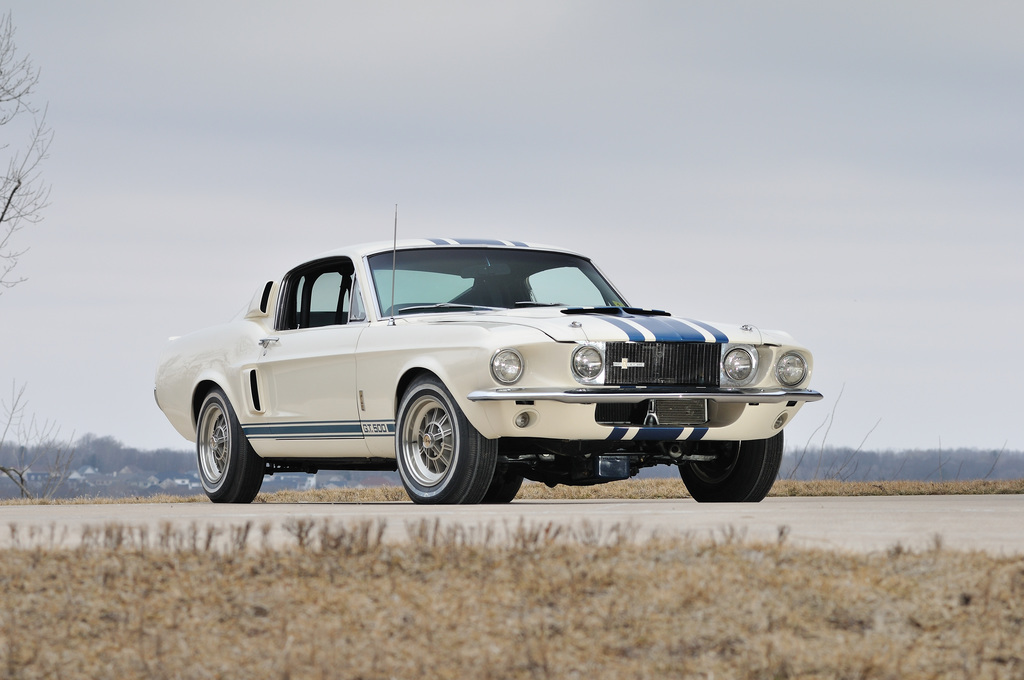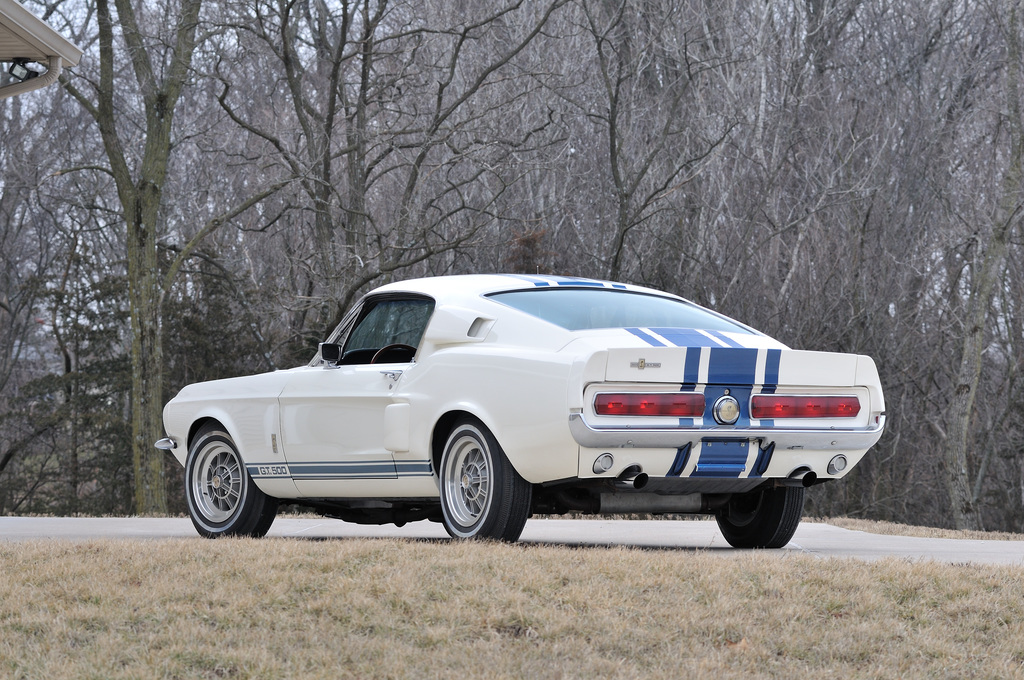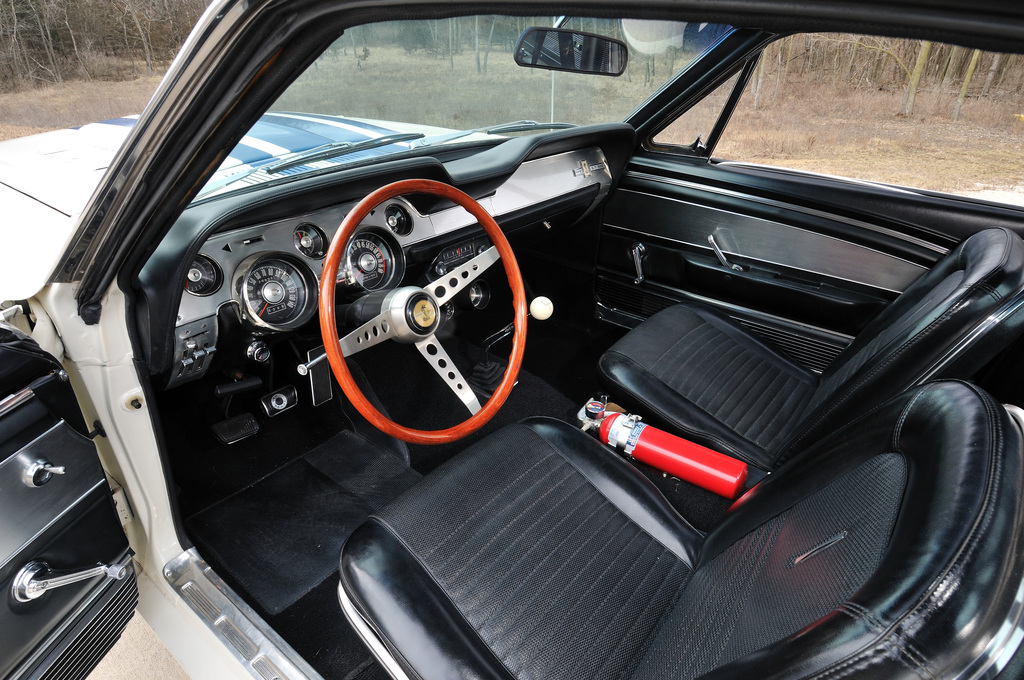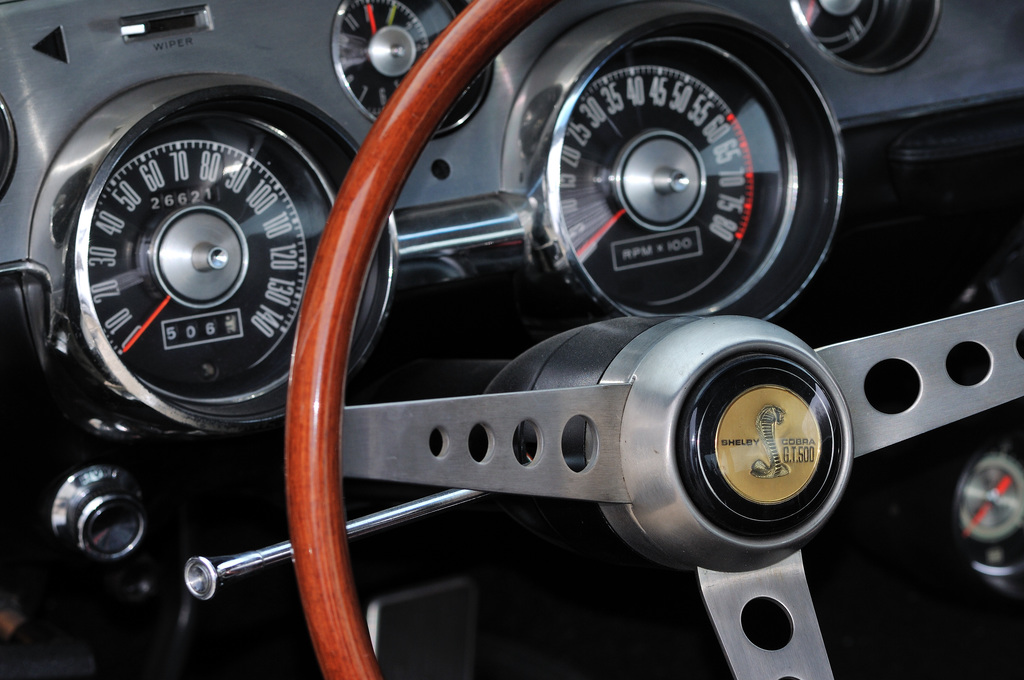1967 Shelby GT500 Super Snake
When Ford redesigned the Mustang in 1967 to take the 390/320 HP big block V-8, Carroll Shelby took the next logical step and introduced the GT500, the first big block Shelby GT, powered by a modified Police Interceptor 428 CI engine rated at 355 HP. Buyers took to the new car immediately, and the car outsold its small block GT350 stable-mate 2,048 to 1,175 units. In addition to his partnership with Ford, Shelby was also the West Coast distributor for Goodyear, who in February asked Shelby to take part in a promotional event for its new Thunderbolt line of economy tires. Shelby judged that the GT500 would be the perfect choice for an extended high-speed demonstration of the new tire, but the decision took a twist when former Shelby American sales manager Don McCain approached Shelby with the idea of building a supercar that would outperform anything else in the world. Then employed by Dana Chevrolet in South Gate, California and Mel Burns Ford in Long Beach, McCain suggested that Carroll put a racing 427 in the GT500 for the test, let him sell the car and then build 50 more for Burns.
Ever one to leap at opportunity, Shelby instructed Fred Goodell, Shelby American’s chief engineer on loan from Ford, to prepare a GT500 with a special engine for the test, which would be held at Goodyear’s high speed test facility near San Angelo, Texas. Goodell selected GT500 number 544 for the task: “We rebuilt it with a special lightweight 427 racing engine; special rear axle, special transmission and, of course, Thunderbolt tires.” Don McCain later described the engine as “the mother of all 427s at that time…aluminum heads, aluminum water pump, forged crank, Le Mans rods, just basically everything inside the engine was built to run sustained 6,000 RPM – to race at Le Mans.” Essentially, it was the same powerplant used in the GT40 Mk II that had won the famous French endurance race the previous year, including a variation on the Mk II’s “bundle of snakes” exhaust system and its output of 600 horsepower. Goodell made other modifications to prepare the car for the tire test. An external oil cooler, braided lines and a remote oil filter were installed to increase the 427’s reliability; stiffer springs and shocks were mounted on the passenger side of the GT500 to counteract the high-speed cornering forces it would encounter on Goodyear’s 5-mile oval track. Goodell completed the car with one-off chrome inboard headlight surrounds and a unique version of the production Le Mans striping, with two narrow Blue stripes flanking a wide Blue center stripe, elements that distinguish it from all other GT500s.
Upon its arrival in Texas the last week of March, the Super Snake was fitted with Shelby 10-spoke aluminum wheels mounted with 7.75-15 Thunderbolt Whitewall tires, which were overinflated with nitrogen to keep the sidewalls rigid and prevent overheating. Before the test commenced, Shelby took a number of invited journalists, including the editors of Time and Life magazines, for demonstration laps around the track. Over the years there were conflicting claims as to who actually drove the car on its 500-mile test, but the story was set straight by Goodell during an interview for an episode of Speed Channel’s “My Classic Car.” After the demonstration runs, during which Shelby reached a top speed of 170 MPH, Goodell recounted, “[Shelby] came back and he handed me his helmet and he says, ‘I’ve got to go to Washington, so you go ahead and drive the test. And so I got back in the car and I drove the car in the 500 mile test. We drove at 142 MPH average for 500 miles.” The test was a complete success: the skinniest tires ever mounted on a Shelby GT, the Thunderbolts had performed flawlessly, retaining 97 percent of their original tread.
The Super Snake was then shipped back to Mel Burns Ford in California, where it remained on display while Don McCain worked to generate interest for a limited run of 50 427-powered GT500s. At over twice the price of a baseline GT500, the Super Snake was priced well beyond its competition, including Shelby’s own 427 Cobra. McCain was forced to admit the car was “just too expensive;” it was ultimately shipped to Dallas where it was purchased by Braniff International Airways pilots James Hadden and James Gorman, who then replaced its original 2.73 gearset with a 4.10 unit for drag racing. Two subsequent owners remain unidentified today, but records show that the car was purchased in 1970 by Bobby Pierce of Benbrock, Texas, who cared for it for 25 years before selling it to David Loebenberg of Florida.
The Super Snake returned to California seven years later when it was bought by Charles Lillard, who later sold it to Richard Ellis, a collector of rare Mustangs in Illinois, at which point the car registered 26,000 miles on the odometer and showed almost no deterioration.
Ellis proceeded with what he describes as a “light restoration,” locating the correct wires and hoses for the engine compartment, a period-correct Rotunda fire extinguisher, NOS Shelby 10-spoke wheels and, amazingly, four brand-new Thunderbolt whitewall tires in the proper size. As Ellis explained in a September, 2011 interview with Auto Enthusiast Magazine, “I wanted to own this piece of Shelby history worse than anything. It was well cared for by its previous owners, but I’ve put a lot of effort into returning it to the state it was in on the day of the tire test.”
“The Thunderbolts were made for … well, boring family cars in the ’60s, which is why nobody reproduces them or has even heard of them for 35 years. I found what has to be the only surviving set in a warehouse in Akron, Ohio. I’m sure Shelby pulled the original Thunderbolts and threw them away when the car got back to California.
“Now, when you see a picture of the Super Snake and it’s got skinny whitewall tires, you’ll know it is either from the Goodyear test or from the time it’s spent in my collection.”
Built with the heart of a Le Mans champion yet ultimately destined for but one day in the sun, there is only one Super Snake, the result of a confluence of forces that could only have happened in the charmed life of one Carroll Shelby.
In Detail
| type | One Of |
| built at | Los Angeles, California, USA |
| production | 1 |
| price $ | $ 5,000 |
| engine | GT40 Mk II V8 |
| position | Front, Longitudinal |
| aspiration | Natural |
| block material | Cast Iron |
| valvetrain | 2 Valves per Cyl, Pushrod Actuated |
| fuel feed | Dual Holley 4-BBL Carburetors |
| displacement | 6997 cc / 427 in³ |
| bore | 108 mm / 4.25 in |
| stroke | 96 mm / 3.78 in |
| redline | 6000 |
| body / frame | Unitary Steel Monocoque |
| driven wheels | RWD |
| front tires | 7.75×15 Goodyear Thunderbolt |
| rear tires | 7.75×15 Goodyear Thunderbolt |
| front brakes | Drums |
| rear brakes | Kelsey-Hayes |
| f suspension | Independent |
| r suspension | Live Axle w/Leaf Springs |
| transmission | 4-Speed Manual |
| top speed | ~228.48 kph / 142 mph |
[youtube https://www.youtube.com/watch?v=zvjhaDmaM1A&w=640&h=510]













